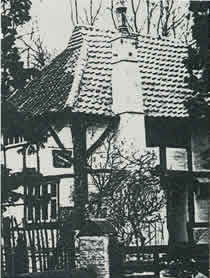|
Oxshott is an enchanting village situated within Surrey's stockbrocker belt and on the railway line from Waterloo to Guildford via Cobham. It lies within a triangle, the points of which are Kingston-upon-Thames, Leatherhead and Guildford. Some 200 years ago it was a small clearing in the woods, with people living in huts, fabricated from timber and straw, with brushwood on the roof and earthen floors. Oxshott village now consists of mainly luxurious houses and a High Street which not long ago had busy thriving shops where ladies dallied to exchange pleasantries and news of the day. Alas, most of that has now disappeared due to supermarket development in neighbouring towns and to heavy traffic which makes crossing the road highly perilous.
Although much has been written about Esher and Cobham, little is to be found about Oxshott. Most history books ignore it and others dismiss it in a few sentences. It could well be that there was nothing of archaeological, architectural, historeical or cultural significance to record. However, Oxshott is soaked in history and touched by prehistory. Samples of sand and gravel from Oxshott Warren are exhibited in the Geological Museum, South Kensington, representing material washed from higher ground during the ice age.
|
A circular object found in Oxshott woods in 1935 is displayed in the British Museum. Nearly 3 cm across, it was given by Mr A Winters in 1955, and is an Anglo-Saxon bronze brooch of the early tenth century. It is intricately carved with 'four small snake heads on banded necks which meet at the centre', and it was made in England. Other objects have been found on Oxshott Heath, such as a flint which was probably part of the head of a spear left by a hunter which, according to experts at Surrey County Council, is the oldest man-made object ever discover4ed in the area, and is said to date back to 8000 B.C.
|
|
|

|
Anglo-Saxon bronze brooch, dated to the 10th Century.
|
Highwayman's Cottage, c1548.
One of the many historical buildings in Oxshott is the Highwayman's Cottage, built in 1548. It is alleged that Dick Turpin or some other notorious bandit lived in the cottage. Since turpin operated mostly in the Nottingham area, it is unlikely, but that some other bandit occupied it is credible, as nearby Portsmouth Road was one of the favourite haunts of robbers.
|
|